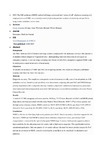PP13 The NHS pathways (NHSP) medical call triage system and new ‘nature of call’ telephone screening tool, employed prior to NHSP, can accurately identify high acuity patients: analysis of sensitivity and specificity using routine ambulance service data
| dc.contributor.author | Green, Jonathan | |
| dc.contributor.author | Ewings, S | |
| dc.contributor.author | Wortham, R | |
| dc.contributor.author | Walsh, B | |
| dc.date.accessioned | 2019-11-29T10:12:32Z | |
| dc.date.available | 2019-11-29T10:12:32Z | |
| dc.date.issued | 2019-01 | |
| dc.identifier.uri | http://hdl.handle.net/10026.1/15211 | |
| dc.description.abstract |
<jats:sec><jats:title>Background</jats:title><jats:p>The NHS Pathways (NHSP) medical call triage system is employed by UK ambulance services. One function is to identify a broad category of ‘high-acuity calls’, distinguishing them from those that do not require an emergency response. A new pre-triage screening tool, Nature of Call (NoC), designed to augment NHSP could be employed as a rapid initial sieve of broad acuity.</jats:p></jats:sec><jats:sec><jats:title>Objectives</jats:title><jats:p>To identify the accuracy of NHSP (and NoC) in recognising patients who require an emergency ambulance response (and therefore those who may not).</jats:p></jats:sec><jats:sec><jats:title>Methods</jats:title><jats:p>Diagnostic accuracy. The sample is a retrospective cohort of consecutive calls, over a 4 month period, to a UK ambulance service. Sensitivity and specificity were determined, comparing allocated NoC and NHS Pathways priority dispositions with a composite reference standard comprised of administered medications, procedures, observations and clinical impressions associated with high-acuity, as recorded on ambulance electronic Patient Clinical Records.</jats:p></jats:sec><jats:sec><jats:title>Results</jats:title><jats:p>A total of 1 87 408 emergency calls were received. Of these, 71 373 were allocated both NoC and NHSP priority dispositions and were associated with electronic Patient Clinical Records. 40 997 (57%) of these patients met the high-acuity reference criteria. NHSP, sensitivity=98.1% (95% CI 98.0 to 98.2); specificity=5.9% (95% CI 5.6 to 6.1). NoC, sensitivity=84.0% (95% CI 83.7 to 84.4); specificity=26.5% (95% CI 26.0 to 27.0).</jats:p></jats:sec><jats:sec><jats:title>Conclusions</jats:title><jats:p>NHSP is effective in identifying high-acuity patients (as is NoC). Sensitivity analysis therefore supports the this function of NHSP and NoC/NHSP to inform initial ambulance dispatch decisions, particularly if NoC categorisation is reviewed in the light of subsequent NHSP triage. However, both systems appear to achieve high sensitivity by also allocating most low-acuity calls to high-acuity categories. This significantly restricts operational application. Only one quarter of low-acuity calls are allocated the lowest priority category by NoC and one-in-seventeen by NHSP, severely restricting the group likely to be considered for alternative care pathways.</jats:p></jats:sec> | |
| dc.language.iso | en | |
| dc.subject | Clinical Research | |
| dc.subject | Health Services | |
| dc.subject | 4.2 Evaluation of markers and technologies | |
| dc.title | PP13 The NHS pathways (NHSP) medical call triage system and new ‘nature of call’ telephone screening tool, employed prior to NHSP, can accurately identify high acuity patients: analysis of sensitivity and specificity using routine ambulance service data | |
| dc.type | presentation | |
| dc.identifier.doi | 10.1136/emermed-2019-999.13 | |
| plymouth.organisational-group | /Plymouth | |
| plymouth.organisational-group | /Plymouth/Faculty of Health | |
| plymouth.organisational-group | /Plymouth/Research Groups | |
| plymouth.organisational-group | /Plymouth/Research Groups/Plymouth Institute of Health and Care Research (PIHR) | |
| plymouth.organisational-group | /Plymouth/Users by role | |
| plymouth.organisational-group | /Plymouth/Users by role/Academics | |
| dc.rights.embargoperiod | Not known | |
| rioxxterms.versionofrecord | 10.1136/emermed-2019-999.13 | |
| rioxxterms.licenseref.uri | http://www.rioxx.net/licenses/all-rights-reserved | |
| rioxxterms.type | Other |


